Life’s rich tapestry: the unsung wonders of textile art

Once seen as a creative backwater thanks to its association with craft and domestic labour, textile or fibre art has emerged as the medium of our moment. The octogenarian Sheila Hicks’s vast, amorphous, rainbow-hued experiments with fibre filled Paris’s Pompidou Centre in 2018, while the late Polish artist Magdalena Abakanowicz’s huge, witchy, labial rope sculptures haunted London’s Tate Modern in 2022.
Now these leading lights can be found within Unravel: The Power and Politics of Textiles in Art. A survey exploring the movement’s inter-generational cross-currents, it encompasses everything from hand-embroidered hankies to big sculptural installations. “Textiles as a term is so capacious and expansive,” says Lotte Johnson, one of Unravel’s three curators. “We’re looking at how cultural dialogues as well as poetic and personal associations speak across geographies and time.”
The thread through the exhibition’s strikingly varied creations is textiles’ potential for political expression. Fibre art first emerged in the 1960s, notably through feminist artists reclaiming “women’s work” for subversive ends. One of the most celebrated artists to come of age then, Judy Chicago, collaborated with needleworkers to create her 1980s series depicting the intensely physical experience of giving birth. This foreshadows more recent explorations of identity and the body, such as the South African artist Nicholas Hlobo’s libidinal anthropomorphic creations on canvas with leather and ribbon. “He uses ribbons because of their association with women’s garments and thus rebellious possibilities,” says Johnson. “These works have been key for his own exploration of sexuality as a gay man.”
For many artists who engage, as Hlobo does, with legacies of violence and discrimination, stitching has potential for healing, be it literally or metaphorically closing wounds or its capacity to bring people together. The show’s historical works include creations on burlap with applique and patchwork made by arpillaristas, anonymous groups of women in Chile, who came together in churches and other community spaces to express the atrocities they endured under Pinochet.
Textiles provide rich stores of ancestral and personal memories, from the traditional Native American garments playfully queered by Choctaw-Cherokee artist Jeffrey Gibson to Chilean artist and poet Cecilia Vicuña’s use of ancient Andean knotting systems. Quilts are a recurring touchstone, such as the now famous Gee’s Bend creations by African American women reworking old clothes into bedspreads on the former plantation. In the hands of one of fibre art’s star names, Faith Ringgold, quilting’s storytelling potential is made explicit in hybrid textiles-cum-paintings protesting racial oppression in the US.
“What make textiles so resonant?” ponders Johnson. “They’re vital to our lives, from the moment that we’re born. We wrap our bodies in them and they’re a tool for communication and thus resistance. They can help us reimagine the world.”
Stitches in time: five textile works in the show
Sheila Hicks, Family Treasures, 1993
One of fibre art’s original innovators, Hicks creates works that range from enormous to tiny. These gem-like bundles of old fabric repurpose clothes that belonged to her friends and family, and illustrate how textiles have been recycled into new forms and purposes throughout history.
Tau Lewis, The Coral Reef Preservation Society, 2019 (main image)
Tau Lewis’s huge work with denim fragments imagines the enslaved women and children thrown overboard during the notorious “middle passage” reborn as deep-sea creatures. She uses the globally popular textile to evoke troubling histories, of cotton plantations and the indigo dye cultivated by the British empire in India.
Tschabalala Self, Koco at the Bodega, 2017
Tschabalala Self, a younger artist influenced by Faith Ringgold, explores the bodegas of her Harlem neighbourhood in the textile painting series that includes this work. For Self, these urban corner shops, peopled by ordinary Black women, have massive economic and political significance.
Tracey Emin, No Chance (What a Year) 1999
This applique blanket suggests comfort and safety, but Emin subverts these homely associations. Rather, with words spelt out in blocky lettering, she uses the form to express the trauma and anger she grappled with after she was raped as a teenager.
Faith Ringgold, Tar Beach 2 1990
The celebrated pioneer of “story quilts” in art, Ringgold revisits her childhood memories of Harlem in this work following the adventures of a young African American girl, Cassie Louise Lightfoot. It gives a fantastical edge to youthful dreams.
Unravel: The Power and Politics of Textiles in Art is at the Barbican Art Gallery, London, 13 February to 26 May.


